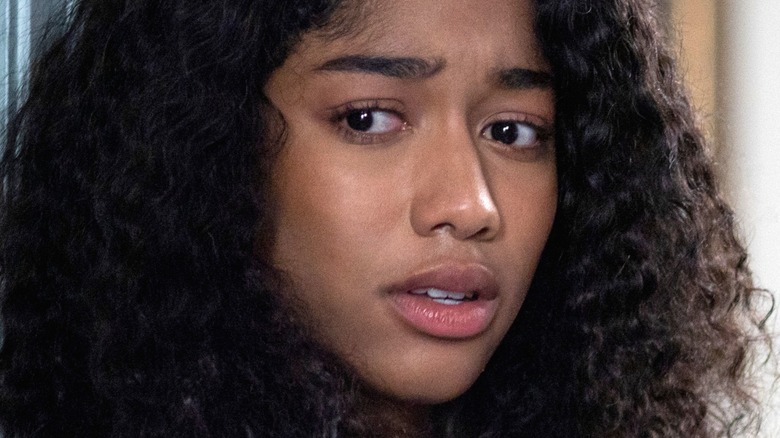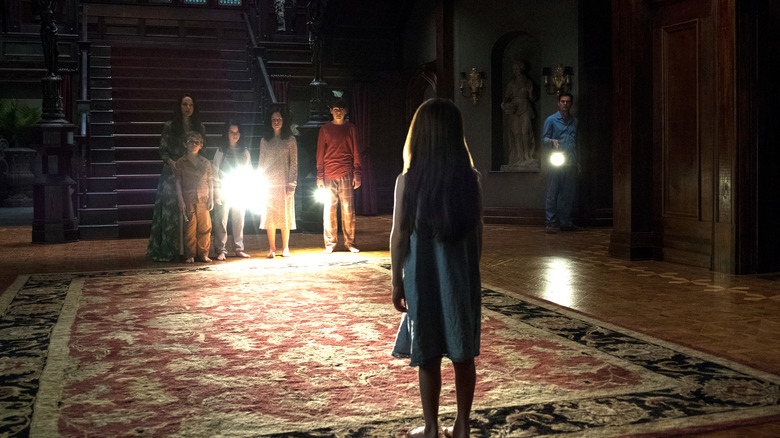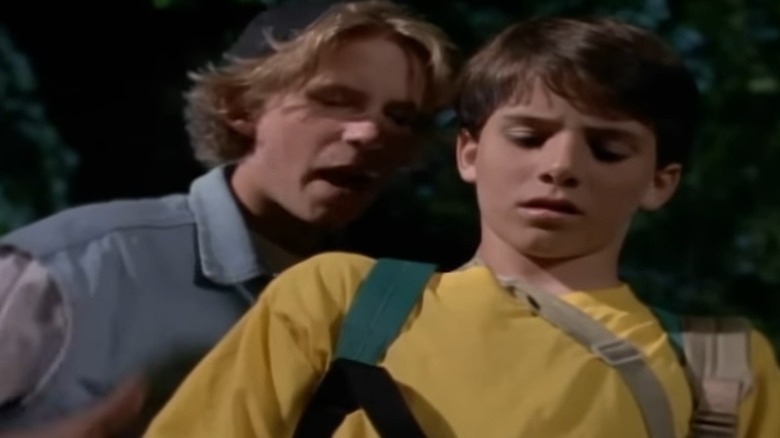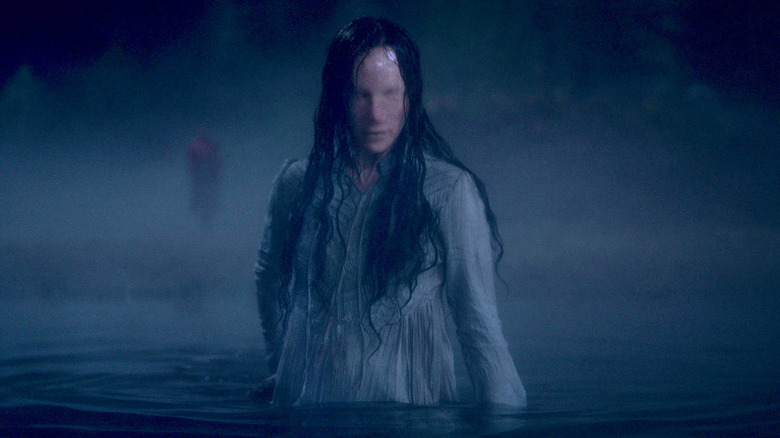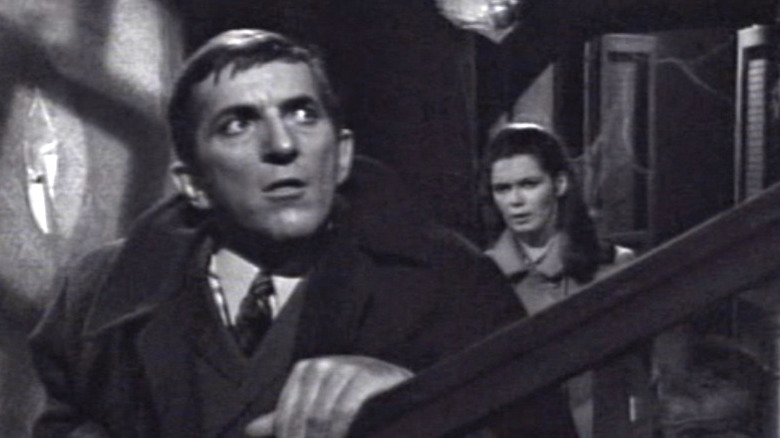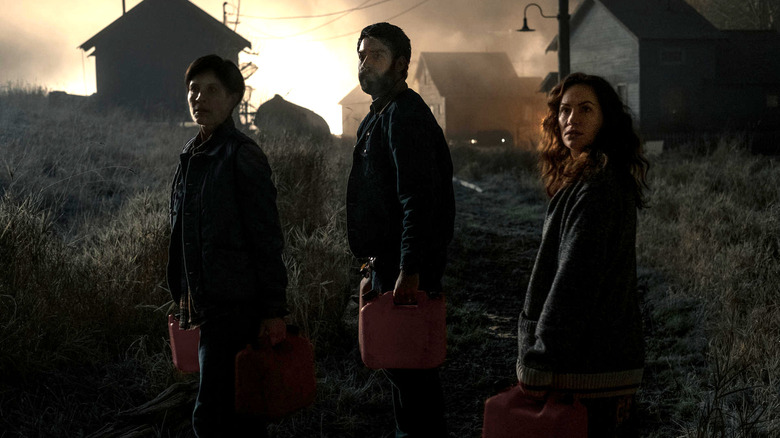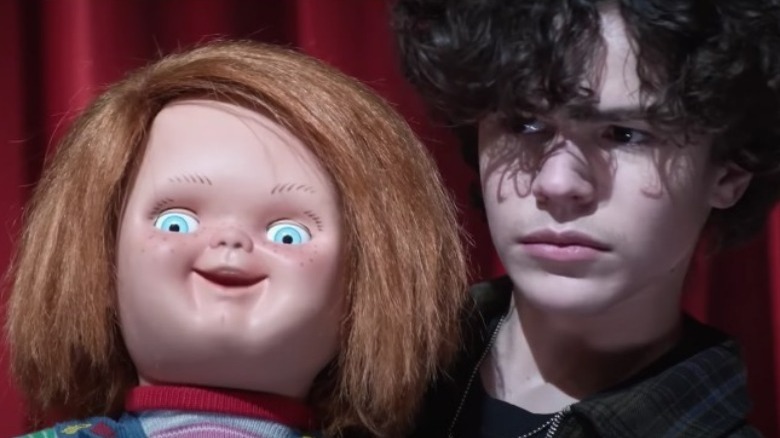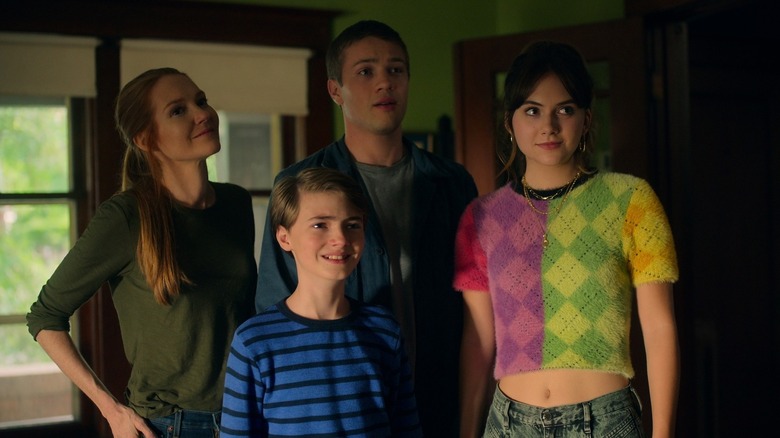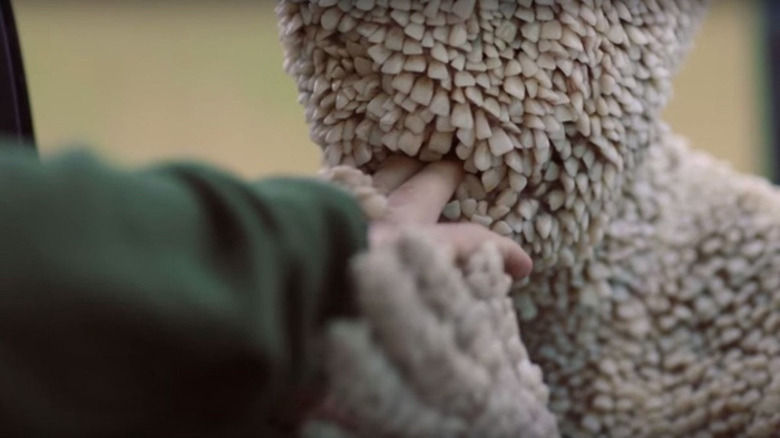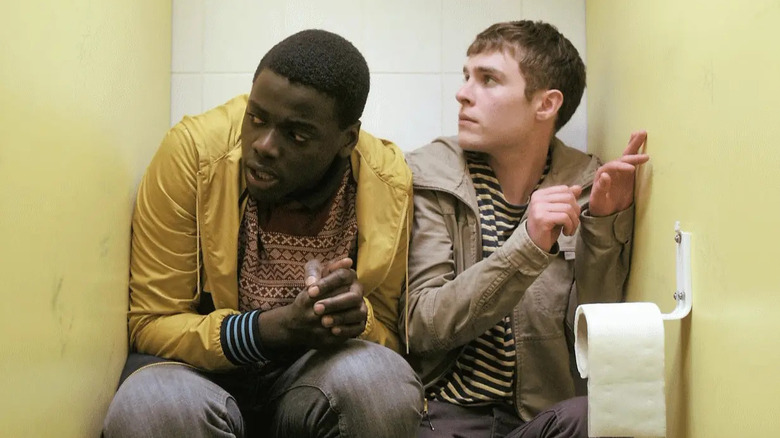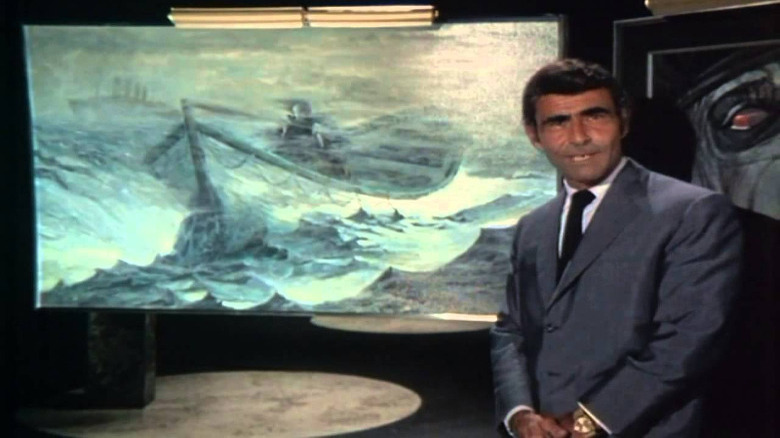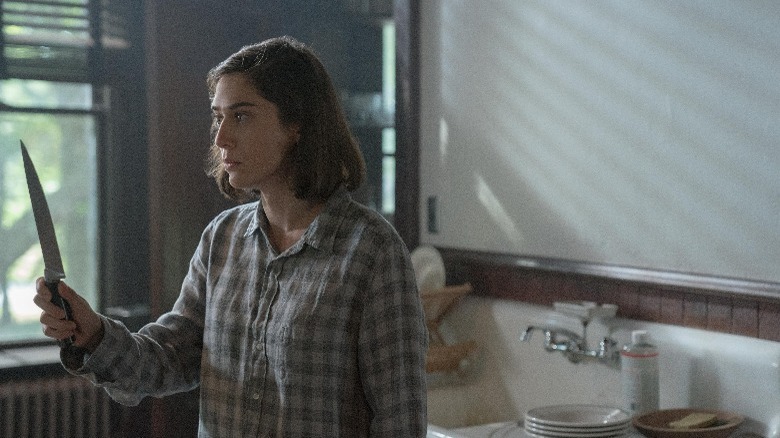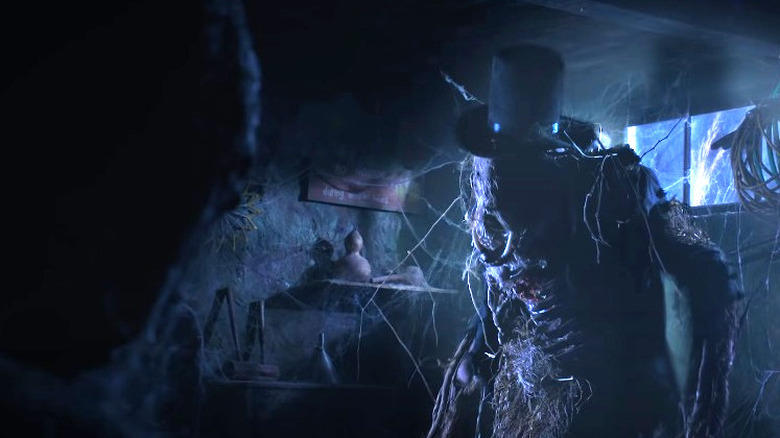12 Spooky Shows To Watch If You Love The Midnight Club
"The Midnight Club" is a young adult horror series about teenagers living in a hospice house who get together at night to tell each other scary stories, forming a bond they hope will carry on to the afterlife. The goal is for the first person who passes away to send a message from beyond the grave to let them know there is life after death. Unfortunately, the club has existed for years and there haven't been any messages received yet, but there are plenty of other mysteries surrounding the house that also require their attention.
The show was co-created by supernatural horror master Mike Flanagan, who has had incredible success with other Netflix horror shows. It is inspired by the works of Christopher Pike, who dominated young adult horror fiction in the '90s by offering more violent and lurid stories than what could normally be found in the novels of R. L. Stine. The creepy setting, heavy subject matter, and very spooky imagery featured in "The Midnight Club" make it perfect viewing for the Halloween season and an excellent gateway into the horror realm.
If you checked out "The Midnight Club" on a whim and felt so captivated by the atmosphere that you wanted to check out other shows like it, then the 12 titles below should give you a properly spooky fix.
The Haunting of Hill House
Mike Flanagan has had great success with Netflix in the past. If you want to find another show that gives you the same vibes as "The Midnight Club," the first thing you should do is seek out his other shows. The first of these was "The Haunting of Hill House" from 2018. It's a complete reimagining of the classic Shirley Jackson novel that explores how a family can be haunted both literally and metaphorically.
Mike Flanagan tends to make slick-looking horror films dripping with atmosphere where a supernatural element is utilized to probe into the dark corners of the human heart and investigate the scars therein. "The Haunting of Hill House" is truly scary because of how well we get to know the family at the center of it. The narrative is broken into two timelines — one is the family living at Hill House and the other is the aftermath decades later.
There are plenty of terrifying ghosts (many of them hidden in the background) and spooky concepts, but our connection to the family is what grounds it and makes us care. With excellent performances from the main cast, which includes Henry Thomas and Carla Gugino, viewers are sucked into the family dynamic immediately and left gripping the edge of their seats until the final episode. Another thing the series shares with "The Midnight Club" — "The Haunting of Hill House" contains what could be some of the greatest jump scares of all time.
Are You Afraid of the Dark
Depending on your age, there is a very good chance that when you heard the title "The Midnight Club" and saw that it was about a group of kids getting together late at night to tell stories, your mind went straight to the '90s Nickelodeon classic that terrified a generation: "Are You Afraid of the Dark?" How could it not? The group of kids in both shows has the word Midnight in their name — in the case of "Are You Afraid of the Dark?" they call themselves The Midnight Society.
"The Midnight Club" isn't strictly an anthology show, but there are plenty of anthology elements. If you've never seen "Are You Afraid of the Dark?" before, then there will be a bit of an adjustment period. Although some of the stories do hold up (and still boast some legitimately terrifying images), it is 30 years old and aimed at a younger audience. If you can get past some of its shortcomings, then you'll have a great time, though.
Then again, if the early '90s production value is too high of a hurdle for you to jump, you could check out the recent revival. The new series is even more like "The Midnight Club" because not only does The Midnight Society tell stories, but they're also stuck in the middle of their own horror story. Both seasons are very different than the original show but are worthy successors.
The Haunting of Bly Manor
"The Haunting of Hill House" is sort of like "American Horror Story" in that each season is its own self-contained story revolving around the history of a haunted house. Season 2 is "The Haunting of Bly Manor," though calling it a second season is a tad misleading as it truly is a brand new story with different characters and priorities that is only similar to "The Haunting of Hill House" in style. You don't need to see one before watching the other, but you probably should just because it's so good.
This time, instead of expanding on the mythology of Hill House, the creators decided to reimagine another timeless horror classic in the form of "The Turn of the Screw" by Henry James. Like the short novel, the series sees a young woman arriving at the manor to serve as governess to two strange kids who are being tormented by the supernatural forces haunting the house. Where it diverges is in the nature of the hauntings. Instead of a dark figure being glimpsed from a distance or a face peering in a window (as in the novel), we get a drowned ghost rising from its watery grave to select a new victim every night — and much more.
Just like in "The Haunting of Hill House," there are images so scary in this show that they will burn their way into your subconscious, but it's the drama between the characters that keeps us invested.
Dark Shadows
You're probably aware of the Tim Burton "Dark Shadows" film from 2012 that reimagined this gothic soap opera as a macabre comedy with Johnny Depp playing a socially inept vampire you could laugh at rather than empathize with, but that's not what we're talking about. If you want to watch something spooky in the best, most surreal, and cheesiest way, then you need to watch the original "Dark Shadows," starting with Episode 211 from 1967, which is the first appearance of the reluctant and lonely vampire Barnabas Collins.
Before Barnabas arrived on the show, it wasn't really supernatural. Instead, in the grand tradition of gothic fiction, it was more about people doing terrible things in an old, dark house. Once the vampire showed up, however, this daily soap opera took a massive leap in quality and became a phenomenon that would later involve time travel, a recurring werewolf character, and some trippy visuals.
If the melodrama of late '60s daytime television isn't your thing, then you could watch the reboot from 1991 which does a great job of condensing everything into an excellent primetime hour-long drama, but it didn't last longer than one season and is notoriously difficult to track down these days. The original series, though, is much easier to find.
Midnight Mass
Aside from directing original horror films, Mike Flanagan also made a name for himself by helming two excellent films based on books written by Stephen King. The first was in 2017 with "Gerald's Game" and the second in 2019 with "Doctor Sleep," which also served as a sequel to Stanley Kubrick's adaptation of "The Shining." After reimagining two classic horror novels for "The Haunting of Hill House" and 'The Haunting of Bly Manor," Flanagan's third Netflix series "Midnight Mass" was an original story that feels like it could have been written by Stephen King.
The series follows a man named Riley Flynn (Zach Gilford) moving back to the island town where he grew up after being released from prison for killing someone in a drunk-driving accident. Haunted by his horrible mistake (once again, literally and figuratively), he finds it difficult to return to any sense of normalcy in the dying town with his strict father, delusional mother, and a suspicious new priest causing all kinds of trouble on the island.
It's similar to the work of Stephen King in terms of setting and subject matter, but it's pure Flanagan with the simmering menace brewing just below the surface that is just as scary as any supernatural horror.
Chucky
Slasher movies may have dominated the 1980s, but very few of those iconic characters made it through the '90s. While Freddy Krueger, Jason Voorhees, and Michael Myers all fizzled out in popularity, the one exception was the maniacal killer doll Chucky, whose career found a second wind in 1998 with the release of "Bride of Chucky." The other horror icons we mentioned all got rebooted at one time (multiple times for "Halloween"), but Chucky's story never ended. Even though an unrelated remake was released in 2019, it didn't stop creator Don Mancini from keeping the original timeline going on television.
"Chucky" picks up where the seventh film "Cult of Chucky" left off and introduces the new protagonist Jake Wheeler (Zackary Arthur), an alienated teenage boy learning to accept his sexuality and battling his urge to lash out at all those who seek to make his life miserable. As Chucky tries to manipulate Jake into becoming a murderer, classic "Child's Play" characters like Andy Barclay (Alex Vincent), his foster sister Kyle (Christine Elise), Chucky's old flame Tiffany Valentine (Jennifer Tilly), and relative newcomer Nica Pierce (first seen in "Curse of Chucky" and played by Fiona Dourif) become embroiled in Chucky's evil scheme.
Ultimately, "Chucky" doesn't require you to have seen the seven films that preceded it (though it helps), and it features the kind of strong friendships in the face of absolute evil you will find in "The Midnight Club."
Locke & Key
Stephen King's son Joe Hill followed in his father's footsteps by writing imaginative horror fiction that gets under your skin while also making you care deeply about his characters. With novels like "Heart-Shaped Box," "Horns," and "NOS4A2," Hill proved that he didn't need to use his father's iconic last name to carve his own demented niche in the world of horror fiction. His comic book series "Locke & Key" also proves that he is a force of nature to be reckoned with.
The comic was adapted in 2020 as a Netflix series that favors the more whimsical elements of the dark fantasy story rather than focus on the grisly, gory details. After her husband is murdered by a former student, Nina Locke relocates her three children to the fictional town of Matheson, Massachusetts (it was Lovecraft in the comic), where they settle into the big, scary house named Keyhouse.
The mysteries hidden within Keyhouse are literally locked behind several doors, all of which require specific keys to be opened. The nature of these mysteries isn't quite the same as those found in "The Midnight Club," but if you really dug the concept of young people in a spooky house battling the supernatural, then you need to check out "Locke & Key."
Channel Zero
Another series that utilizes the "American Horror Story" model of telling a new scary story every season is the SyFy channel's "Channel Zero." Despite being packed with images that feel like they were plucked directly from your own personal nightmares, the show has remained somewhat underseen. This is a real shame because it boasts not only some of the most startling creature effects to ever be committed to television, but it has the most oppressively unsettling and disturbing atmosphere of every title on this list.
Created by Nick Antosca and featuring an incredible writing staff that includes "Chucky" creator Don Mancini, the show takes inspiration from the classic creepypastas "Candle Cove," "NoEnd House," "Search and Rescue Woods" and "Hidden Door" to tell new, disturbing, and totally original stories that linger in your gut. For just a taste of what kind of trip you're in for by dialing into "Channel Zero," just watch this very short clip of a creature covered in human teeth sneaking up on an unsuspecting driver looking for a snack. If that makes your skin crawl (and it should), then check out this show ASAP because there's a ton more where that came from.
The Fades
Things take a slightly different direction with our list with this entry, as "The Fades" definitely veers into more sci-fi territory than straight-up horror, but there are plenty of spooky scares packed into its one and only season to include it here. The series came out in 2011, a time when young adult sci-fi novels were taking over the world, with series like "The Hunger Games," "The Maze Runner," and "Divergent" at the height of their popularity. This BBC Three series utilize the post-apocalyptic setting of these stories, but it has enough similar elements to be counted amongst the rest.
If anything, you could call this a pre-apocalyptic YA story since the main character, Paul Roberts (Iain De Caestecker), is fighting a battle to prevent the end of the world as we know it. He is what this fictional world calls an Angelic, meaning he is able to see the malevolent spirits of the dead, which are referred to as the Fades. He gets recruited by other Angelics to stop the Fades from taking over the world, and there's a bunch of creepy imagery to keep you on the edge of your seat. Also, this is an early role for Daniel Kaluuya, which makes it worth checking out for that alone.
Night Gallery
Everyone remembers Rod Serling's iconic and influential sci-fi anthology series "The Twilight Zone" for a good reason — it is a collection of stone-cold masterpieces that are both universal and timeless, the majority of which can be watched over and over again. The same, sadly, cannot be said for another anthology series the genius writer hosted called "Night Gallery." Although he was creatively involved in some of the series, his role was relegated primarily to that of the host, a mysterious man telling us the dark and twisted backstories of various paintings hanging in the titular gallery.
In general, these stories don't hold up quite as well as those found in "The Twilight Zone" because they're not exploring human truths through allegory, or really even addressing anything larger than the stories being told. They also don't hold up as well because the production values of the time became dated in less than a decade, whereas the filming techniques and costumes in 'The Twilight Zone" continue to sparkle in dazzling black and white.
Looking past all that, though, "Night Gallery" is actually a very effective series of haunting gothic horror stories that are perfect for rainy afternoons or dark nights when sunrise feels years away. If you're looking for a show that will give you that spooky feeling that's difficult to shake, then "Night Gallery" is for you.
Castle Rock
Like "The Midnight Club," which takes inspiration from the general catalog of books written by Christopher Pike, the Hulu original series "Castle Rock" is inspired by almost the entirety of Stephen King's bibliography. Instead of adopting a single book into an epic television series (which had previously been done with "Under the Dome"), the creators decided to take the fictional town of Castle Rock in Maine and build an entire series around it by pulling from elements of King's work like locations and characters.
Viewers meet a young Annie Wilkes (Lizzy Caplan) from "Misery" before she kidnaps her favorite writer and mutilates his feet, as well as the niece of Jack Torrance from "The Shining," a Castle Rock historian who goes by the name Jackie Torrance (Jane Levy), and there are a ton of references and easter eggs throughout. The series kicks off when officers working at the Shawshank State Prison discover a young man (played by Pennywise himself, Bill Skarsgård) locked away in an abandoned part of the prison following the suicide of the previous warden. The secret of what he was doing there and Castle Rock's dark past serve as the central engine driving the series.
Creepshow
In 1982, horror icons George A. Romero and Stephen King joined forces to pay homage to EC Comics like horror stories such as "Tales From the Crypt" and "The Vault of Horror," with a stylized and retro horror anthology film titled "Creepshow." The sequel, "Creepshow 2," followed in 1987, with both men taking a bit of a backseat, followed by a third one nobody talks about. In the case of both films, the stories were mostly based on short stories penned by King, and that tradition carried over to launch a 2019 Shudder original series also titled "Creepshow."
The series is obviously working with a limited budget but the passion of the folks behind the scenes, such as creator Greg Nicotero and writers like Dana Gould and John Harrison (along with some powerhouse guest stars), rose to the occasion to produce something that honors the original films. The series also expands the pool of short stories that serve as inspiration for many of these tales — not all of them are Stephen King stories this time around.
"Creepshow" is a show that runs the horror gamut from atmospheric and spooky to hilariously over-the-top while finding a way to include everything in between. If you're not ready to commit to serialized TV after finishing "The Midnight Club" but still want something super spooky, check out this excellent anthology.
